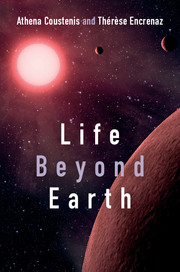Book contents
- Frontmatter
- Contents
- Preface
- 1 Introduction
- 2 What is life and where can it exist?
- 3 Terrestrial planets and their diverging evolutions
- 4 Searching for habitable sites in the outer Solar System
- 5 A revolution in astronomy: the exploration of extrasolar planets
- 6 Extraterrestrial habitable sites in the future
- Further reading
- Index
- Plate Section
6 - Extraterrestrial habitable sites in the future
Published online by Cambridge University Press: 05 October 2013
- Frontmatter
- Contents
- Preface
- 1 Introduction
- 2 What is life and where can it exist?
- 3 Terrestrial planets and their diverging evolutions
- 4 Searching for habitable sites in the outer Solar System
- 5 A revolution in astronomy: the exploration of extrasolar planets
- 6 Extraterrestrial habitable sites in the future
- Further reading
- Index
- Plate Section
Summary
Exploring the Solar System remotely and in situ
Our exploration of Solar System habitats will continue with our usual astronomical means: ground-based telescopes, space observatories and in situ missions. Following the present generation of 10-metre class telescopes, astronomers are now working on the next step: a 30–40-m telescope. Three projects are currently being studied, two in the United States and one in Europe. On the American side, the GMT (Giant Magellan Telescope), made of seven 8-m telescopes, to be installed at Las Campanas in Chile, will reach an equivalent diameter of 21 m; the Thirty Meter Telescope (TMT), to be installed at Mauna Kea Observatory in Hawaii, will consist of a primary mirror composed of 492 hexagonal segments of 1.45 m diameter. Finally, the European ELT (E-ELT; Figure 6.1), to be installed at Cerro Armazones in Chile, will reach a diameter of 39 m by using about 800 hexagonal elements of 1.45 m diameter each. The first light of the E-ELT is planned for 2021. The E-ELT will be of special interest for the spectroscopy of transiting exoplanets, but will also be very useful for Solar System exploration, in particular the study of comets and trans-Neptunian objects.
As a follow-up to the HST, the New Generation Space Telescope, now renamed the James Webb Space Telescope (JWST; Figure 6.2) is built by NASA in partnership with ESA. This 6-m diameter telescope will be dedicated to infrared astronomical observations, from 0.6 to 28 μm. The spacecraft will be located at a special orbital position known as the L2 Lagrangian point of the Sun–Earth system, beyond the Earth on the Sun–Earth axis, a stable position much favoured by astronomical spacecraft. Its main scientific objectives are cosmology and exoplanets, but will also be a prime tool for Solar System exploration, especially for small bodies in the outer Solar System. It is expected to be launched in 2018 on an Ariane 5 rocket.
- Type
- Chapter
- Information
- Life beyond EarthThe Search for Habitable Worlds in the Universe, pp. 235 - 274Publisher: Cambridge University PressPrint publication year: 2013

